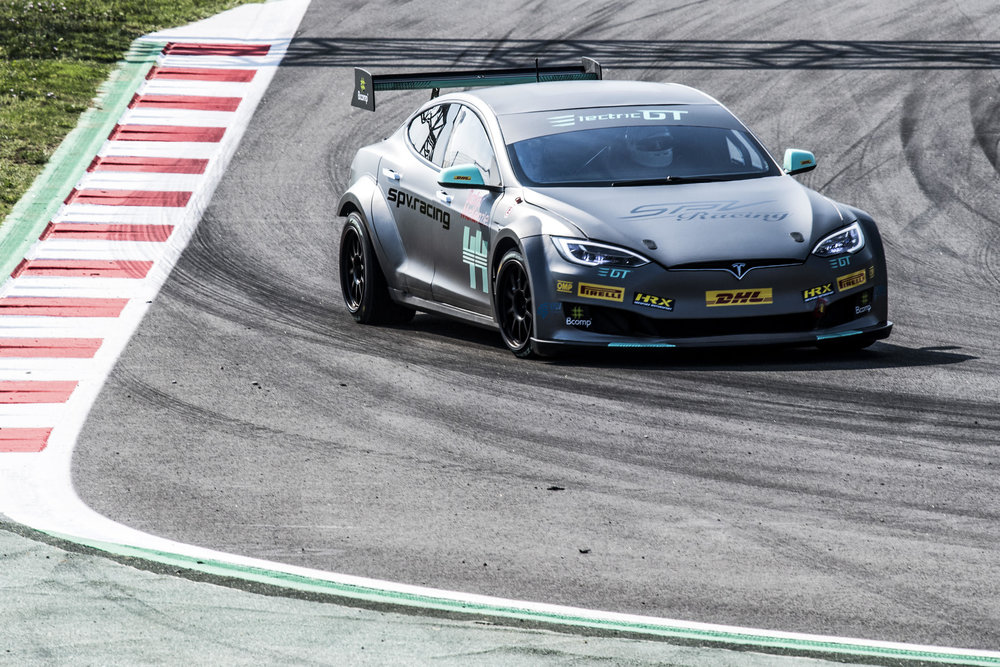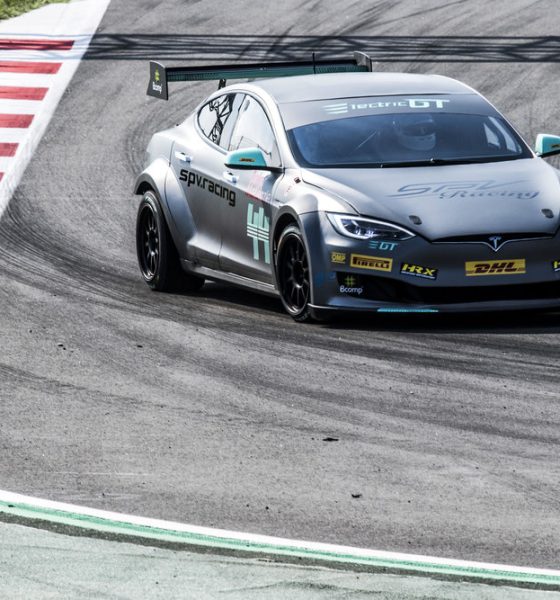

News
Tesla Model S P100DL racing series Electric GT hits another delay
Back in April, the Electric Production Car Series, better known as Electric GT, revealed an eight-round calendar for its inaugural season, which was expected to begin this November at Jerez, Spain. The organization later unveiled its first race-ready vehicle, a highly-modified Tesla Model S P100DL, that is optimized for the track. Unfortunately, recent updates from Electric GT indicates that the racing series would be delayed yet again.
Electric GT was originally expected to begin in 2017, but delays forced the organization to push back the debut of the all-electric, Tesla-exclusive racing series. This time around, EGT noted that it was delaying the launch of the series since it is still seeking a lead investor. In a statement to Autosport, EGT CEO Mark Gemmell stated that almost everything is ready — from the series’ racing categories, FIA approval, and technical and broadcast partners. With an investor in the picture, Gemmell noted that the racing series could begin as early as the first half of 2019.
“Accelerating development in both electric mobility and sustainable energy means ‘The Age of Light’ will fast be with us. The Age of Light is a vision that has driven us for over three years to build an Electric Production Car Series that excites and inspires, and it is now close to final launch. Almost everything is ready: we’ve developed three fantastic race categories, received FIA approval and welcomed new technical and broadcast partners.
“The final ingredient is confirming a great lead investor who shares our vision of clean energy and transport, which is fundamental to launching the championship at the highest level possible. The championship start date will be set once this lead investor has been confirmed. As any start-up, we adapt and test our strategy to make sure the timing is right and the market ready. In creating an engaging and inclusive championship, we want to be open with our fans and supporters as we close in on this final step to bring the racing we all want to see.”
Last July, Electric GT showcased its first track-optimized Tesla Model S P100DL, where it was test-driven by veteran auto host Tiff Needell, who drove the vehicle around the Circuit de Barcelona-Catalunya in Barcelona. Needell, a former racing driver and presenter for programs such as Top Gear and Fifth Gear, was largely impressed with the track-optimized Model S P100DL, as the vehicle was powerful and it remained planted on the road despite performing aggressive maneuvers on the racetrack.
Unfortunately, Needell’s track session was cut short when Electric GT’s race-modified Model S P100DL exhibited heating issues after one lap and a half of hard driving, forcing the former racecar driver to head over to the pits, where the P100DL had to be cooled down. A spokesperson from EGT later issued a statement about the incident, explaining that the heating issue was caused by one of the vehicle’s outdoor temperature sensors from the air conditioning system being disconnected.
The Tesla Model S P100DL is a monster on straight-line races, but its limitations on the track are well documented. Electric GT is aware of this, and it has developed a system that could address the vehicles’ heating issues. The organization plans to introduce a system that would allow drivers to manage how much of the vehicle’s power they wish to use. Thus, to avoid overheating, drivers could opt to drive with a more manageable 470 hp, and only unleash the Model S P100DL’s full 778 hp when sprinting or overtaking. The Electric GT spokesperson noted that for the inaugural season, at least, the system will be “part of the strategy and part of the show.”

News
Tesla China delivery centers look packed as 2025 comes to a close
Needless to say, it appears that Tesla China seems intent on ending 2025 on a strong note.

Tesla’s delivery centers in China seem to be absolutely packed as the final days of 2025 wind down, with photos on social media showing delivery locations being filled wall-to-wall with vehicles waiting for their new owners.
Needless to say, it appears that Tesla China seems intent on ending 2025 on a strong note.
Full delivery center hints at year-end demand surge
A recent image from a Chinese delivery center posted by industry watcher @Tslachan on X revealed rows upon rows of freshly prepared Model Y and Model 3 units, some of which were adorned with red bows and teddy bears. Some customers also seem to be looking over their vehicles with Tesla delivery staff.
The images hint at a strong year-end push to clear inventory and deliver as many vehicles as possible. Interestingly enough, several Model Y L vehicles could be seen in the photos, hinting at the demand for the extended wheelbase-six seat variant of the best-selling all-electric crossover.
Strong demand in China
Consumer demand for the Model Y and Model 3 in China seems to be quite notable. This could be inferred from the estimated delivery dates for the Model 3 and Model Y, which have been extended to February 2026 for several variants. Apart from this, the Model Y and Model 3 also continue to rank well in China’s premium EV segment.
From January to November alone, the Model Y took China’s number one spot in the RMB 200,000-RMB 300,000 segment for electric vehicles, selling 359,463 units. The Model 3 sedan took third place, selling 172,392. This is quite impressive considering that both the Model Y and Model 3 are still priced at a premium compared to some of their rivals, such as the Xiaomi SU7 and YU7.
With delivery centers in December being quite busy, it does seem like Tesla China will end the year on a strong note once more.
News
Tesla Giga Berlin draws “red line” over IG Metall union’s 35-hour week demands
Factory manager André Thierig has drawn a “red line” against reducing Giga Berlin’s workweek to 35 hours, while highlighting that Tesla has actually increased its workers’ salaries more substantially than other carmakers in the country.

Tesla Giga Berlin has found itself in a new labor dispute in Germany, where union IG Metall is pushing for adoption of a collective agreement to boost wages and implement changes, such as a 35-hour workweek.
In a comment, Giga Berlin manager André Thierig drew a “red line” against reducing Giga Berlin’s workweek to 35 hours, while highlighting that Tesla has actually increased its workers’ salaries more substantially than other carmakers in the country.
Tesla factory manager’s “red line”
Tesla Germany is expected to hold a works council election in 2026, which André Thierig considers very important. As per the Giga Berlin plant manager, Giga Berlin’s plant expansion plans might be put on hold if the election favors the union. He also spoke against some of the changes that IG Metall is seeking to implement in the factory, like a 35-hour week, as noted in an rbb24 report.
“The discussion about a 35-hour week is a red line for me. We will not cross it,” Theirig said.
“(The election) will determine whether we can continue our successful path in the future in an independent, flexible, and unbureaucratic manner. Personally, I cannot imagine that the decision-makers in the USA will continue to push ahead with the factory expansion if the election results favor IG Metall.”
Giga Berlin’s wage increase
IG Metall district manager Jan Otto told the German news agency DPA that without a collective agreement, Tesla’s wages remain significantly below levels at other German car factories. He noted the company excuses this by referencing its lowest pay grade, but added: “The two lowest pay grades are not even used in car factories.”
In response, Tesla noted that it has raised the wages of Gigafactory Berlin’s workers more than their German competitors. Thierig noted that with a collective agreement, Giga Berlin’s workers would have seen a 2% wage increase this year. But thanks to Tesla not being unionized, Gigafactory Berlin workers were able to receive a 4% increase, as noted in a CarUp report.
“There was a wage increase of 2% this year in the current collective agreement. Because we are in a different economic situation than the industry as a whole, we were able to double the wages – by 4%. Since production started, this corresponds to a wage increase of more than 25% in less than four years,” Thierig stated.
News
Tesla is seeing a lot of momentum from young Koreans in their 20s-30s: report
From January to November, young buyers purchased over 21,000 Teslas, putting it far ahead of fellow imported rivals like BMW and Mercedes-Benz.

Tesla has captured the hearts of South Korea’s 20s-30s demographic, emerging as the group’s top-selling imported car brand in 2025. From January to November, young buyers purchased over 21,000 Teslas, putting it far ahead of fellow imported rivals like BMW and Mercedes-Benz.
Industry experts cited by The Economist attributed this “Tesla frenzy” to fandom culture, where buyers prioritize the brand over traditional car attributes, similar to snapping up the latest iPhone.
Model Y dominates among young buyers
Data from the Korea Imported Automobile Association showed that Tesla sold 21,757 vehicles to the 20s-30s demographic through November, compared to BMW’s 13,666 and Mercedes-Benz’s 6,983. The Model Y led the list overwhelmingly, with variants like the standard and Long Range models topping purchases for both young men and women.
Young men bought around 16,000 Teslas, mostly Model Y (over 15,000 units), followed by Model 3. Young women followed a similar pattern, favoring Model Y (3,888 units) and Model 3 (1,083 units). The Cybertruck saw minimal sales in this group.
The Model Y’s appeal lies in its family-friendly SUV design, 400-500 km range, quick acceleration, and spacious cargo, which is ideal for commuting and leisure. The Model 3, on the other hand, serves as an accessible entry point with lower pricing, which is valuable considering the country’s EV subsidies.
The Tesla boom
Experts described Tesla’s popularity as “fandom culture,” where young buyers embrace the brand despite criticisms from skeptics. Professor Lee Ho-geun called Tesla a “typical early adopter brand,” comparing purchases to iPhones.
Professor Kim Pil-soo noted that young people view Tesla more as a gadget than a car, and they are likely drawn by marketing, subsidies, and perceived value. They also tend to overlook news of numerous recalls, which are mostly over-the-air software updates, and controversies tied to the company.
Tesla’s position as Korea’s top import for 2025 seems secured. As noted by the publication, Tesla’s December sales figures have not been reported yet, but market analysts have suggested that Tesla has all but secured the top spot among the country’s imported cars this year.








